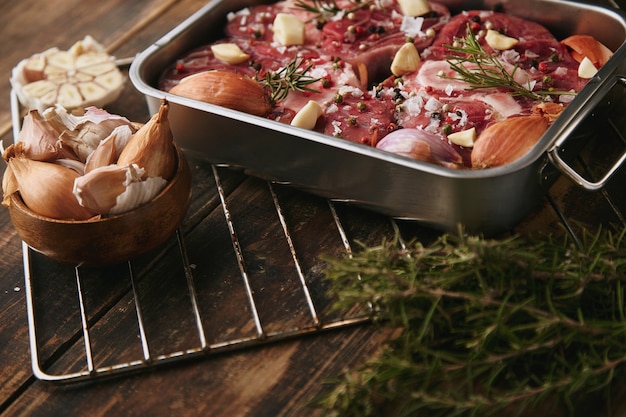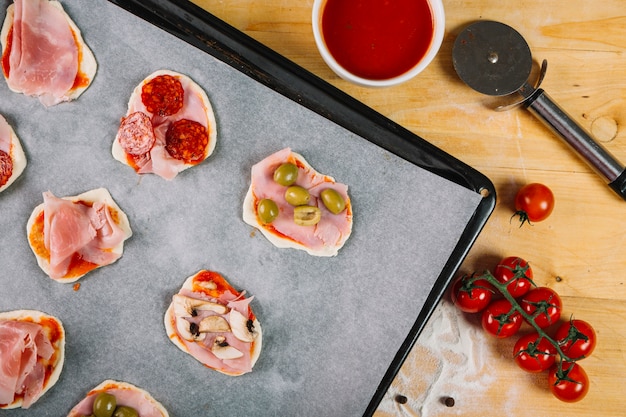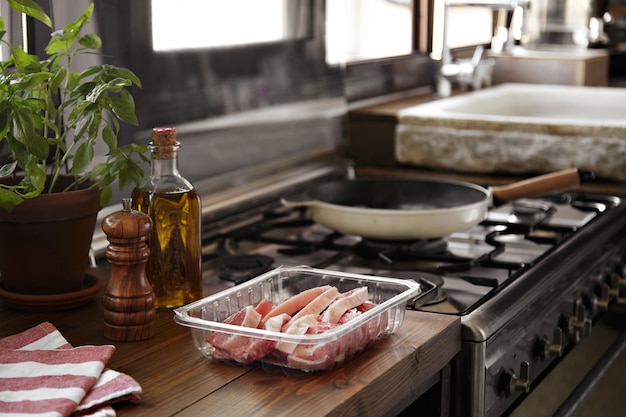You're looking to cook up some Canadian bacon, eh? Maybe you've seen it on a menu, maybe you’ve heard it called "back bacon" or even "peameal bacon," and you're curious about this unique type of bacon. Let me tell you, it's a whole different ball game compared to the thick-cut, American-style bacon we all know and love (or maybe "love" is a strong word – let's just say it’s a guilty pleasure). But don’t worry, I’m here to be your guide, your culinary companion on this delicious adventure. From understanding the basics to mastering the art of cooking Canadian bacon, we'll dive deep, and by the end, you’ll be whipping up bacon-infused breakfasts like a pro. I'll be honest, I wasn't always a Canadian bacon aficionado. I was a bit skeptical at first, picturing some thin, bland piece of meat. Boy, was I wrong! Let's get started, shall we?
(Part 1) What in the World is Canadian Bacon?

First things first, let's clear the air about what Canadian bacon actually is. It's not actually Canadian, although Canadians have embraced it as their own. It actually originated in England, where it's known as "back bacon." The name "Canadian bacon" was coined by American cooks and restaurateurs in the 1960s, becoming popular after appearing on breakfast menus at the Montreal World's Fair in 1967. It's a cousin, not a copycat, of the American bacon we’re all familiar with. It’s made from the loin, not the belly, of the pig, which gives it a leaner, more tender texture. No, you won't find any smoky barbecue flavour here – it's a completely different flavour profile. Think of it as a lighter, more delicate taste with a hint of sweetness.
What Makes Canadian Bacon Special?
While the name might be a bit misleading, the flavour and texture are what truly set Canadian bacon apart. Here’s why I love it:
- Lean and Tender: Canadian bacon is leaner than American bacon, making it a healthier choice. It's also incredibly tender and juicy, thanks to the loin cut.
- Subtle Sweetness: It has a unique, delicate sweetness that comes from the curing process. It's not overpowering, just a hint of sweetness that complements the savoury flavour.
- Versatile: Canadian bacon can be cooked in a variety of ways and adds a delightful touch to so many dishes. Think of it as a culinary chameleon – it transforms to fit any dish!
The "Peameal" Mystery
Now, you might have heard it called "peameal bacon." What’s the deal with that? Well, it's essentially the same thing – Canadian bacon, but with a special coating of cornmeal. It’s often a Canadian staple, especially in the province of Ontario. The cornmeal acts like a protective layer during the curing process, preventing the bacon from becoming too salty and adding a slightly crunchy texture. You'll find it pre-packaged, ready to cook. But, don't let the name fool you, it's not actually made with peas! The term "peameal" is a shortened version of "peasemeal," which was a type of coarse oatmeal used for coating meat in the past. However, nowadays, modern peameal bacon is coated with yellow cornmeal. It's a tasty and unique Canadian tradition!
(Part 2) Choosing the Right Canadian Bacon: A Buyer's Guide

Okay, now that you’ve got the basics down, let’s talk about picking the perfect Canadian bacon. It's like finding the right ingredients for a delicious recipe – you want to start with something good! There are a few things to keep in mind when choosing your bacon:
1. Thick or Thin?
Canadian bacon can be found in a variety of thicknesses. You'll find thin slices (around 1/8 inch), thick slices (1/4 inch or more), and even those "Canadian bacon steaks" that are a couple of inches thick and perfect for grilling. It really comes down to personal preference and what you're planning to do with it. Personally, I prefer thin slices for breakfast sandwiches, and thicker slices for a hearty brunch dish. Thin slices are ideal for breakfast sandwiches or adding to salads, while thicker slices are perfect for grilled meals or hearty brunch dishes.
2. The Salt Factor: How Salty is Too Salty?
Canadian bacon is often cured with salt, so it's important to consider how salty you want your bacon to be. Some brands are saltier than others. If you're watching your sodium intake, be sure to check the label. You can always rinse the bacon before cooking to remove some of the salt, though it may also wash away some of the flavour. For a milder saltiness, look for "low-sodium" or "reduced sodium" varieties.
3. Where to Buy the best bacon
You can find Canadian bacon in most supermarkets and butcher shops. My advice? Don't be afraid to ask the butcher! They’ll be able to guide you towards the best quality bacon, whether it’s thick-cut, thin-cut, or even a special order for a unique cut. Some specialty stores might offer more unique varieties, too. And, if you're really adventurous, consider trying to find "peameal bacon." It's a true Canadian delicacy! Look for bacon that has a good colour, is evenly sliced, and smells fresh. Avoid bacon that has a dull colour or a slimy texture.
(Part 3) Cooking Canadian Bacon: From Pan to Oven

Now, the fun part: cooking! It's all about getting that perfect balance of crispiness and juiciness. I’ve experimented with lots of different methods, and here are some of the best ways to cook Canadian bacon:
1. Pan-Fried: Simple and Delicious
This is my go-to method for a quick and easy breakfast. Here’s how to do it:
- Heat a skillet over medium heat. No need for oil, Canadian bacon has enough fat to cook itself.
- Add the bacon to the pan, making sure not to overcrowd the skillet.
- Cook for 2-3 minutes per side, or until golden brown and crispy.
- Remove the bacon from the pan and drain on paper towels.
That’s it! Easy peasy, right? For added flavour, you can add a little butter or oil to the pan, or even a sprinkle of herbs like thyme or rosemary. You can also try adding a squeeze of lemon juice towards the end of cooking for a bright tang.
2. Baked to Perfection: For Large Batches and More Even Cooking
If you’re cooking a big batch for a crowd, or just want a more hands-off approach, baking is the way to go. Here’s how to do it:
- Preheat your oven to 400 degrees Fahrenheit (200 degrees Celsius).
- Place the bacon slices on a baking sheet lined with parchment paper.
- Bake for 10-15 minutes, or until golden brown and crispy.
You can also add a little sugar to the baking sheet for a caramelized finish, or sprinkle with a little paprika for a touch of colour. The beauty of baking is that it cooks the bacon evenly, so you won't have any soft spots. Just keep an eye on it towards the end of cooking time to make sure it doesn’t burn.
3. Grilled to Glory: For a Smoky Flavour
If you’re looking to add a little smoky flavour to your Canadian bacon, grilling is the way to go. Here’s how to do it:
- Preheat your grill to medium-high heat.
- Place the bacon slices on the grill.
- Cook for 2-3 minutes per side, or until golden brown and crispy.
For an even smokier flavour, you can try grilling the bacon over wood chips or using a smoker. Just be careful not to overcook it – the grill can heat up quickly, and you don’t want to end up with burnt bacon! You can also use a grill pan on the stovetop for a similar effect.
(Part 4) Canadian Bacon: Beyond the Breakfast Plate
Let’s be honest, Canadian bacon is amazing on its own, but it’s also incredibly versatile. It goes beyond breakfast and shines in so many other dishes!
1. Elevate Your Sandwiches
Canadian bacon is a perfect addition to any sandwich. Think of it as a gourmet twist on the classic BLT. You can add it to your favourite sandwiches, like turkey sandwiches, ham and cheese, or even veggie burgers. The salty, sweet flavour adds a layer of complexity that takes your sandwiches from ordinary to extraordinary!
2. The Perfect Salad Topping
Canadian bacon adds a delicious crunch and savoury flavour to any salad. Think of it as a healthy, protein-packed alternative to croutons. You can add it to Caesar salads, green salads, or even fruit salads. It’s also perfect for a summery pasta salad. Just remember to chop it into smaller pieces for easier eating.
3. A Touch of Class to Your Brunch Dishes
Canadian bacon is the ultimate brunch star! It’s delicious in quiche, frittatas, and omelets. It also adds a touch of elegance to brunch platters. Just pair it with some fluffy eggs, fresh fruit, and your favourite brunch staples for a truly satisfying meal.
4. Creative Culinary Creations
Don’t be afraid to get creative with Canadian bacon! It’s a delicious addition to pizzas, pastas, and even soups. You can also use it to make bacon-wrapped appetizers, like dates or shrimp. The possibilities are endless!
(Part 5) Mastering the Art of Cooking Canadian Bacon: Tips and Tricks
Here are some tips and tricks that I’ve learned over the years to help you cook Canadian bacon like a pro:
1. Don't Overcook It
The key to perfect Canadian bacon is to cook it just until it’s golden brown and crispy. Overcooking can result in dry, chewy bacon.
2. Use a Thermometer
If you’re not sure if your bacon is cooked through, use a meat thermometer. The internal temperature should reach 145 degrees Fahrenheit (63 degrees Celsius).
3. Pat it Dry
Before cooking, pat the bacon dry with paper towels. This will help to prevent it from steaming in the pan and becoming soggy.
4. Don't Crowd the Pan
If you crowd the pan, the bacon will steam instead of crisp up. Cook in batches if necessary.
5. Let it Rest
Once the bacon is cooked, let it rest on paper towels for a few minutes. This will allow the fat to drain and the bacon to crisp up even more.
(Part 6) Storing Your Canadian Bacon: Keeping it Fresh
Right, you've got your delicious Canadian bacon, but now you need to know how to keep it fresh and tasty for later. Here's the lowdown:
1. Refrigeration Rules
Canadian bacon should be stored in the refrigerator in an airtight container or wrapped tightly in plastic wrap. It will last for up to 5 days in the fridge.
2. Freezing for Future Delights
You can also freeze Canadian bacon for up to 3 months. To freeze, wrap the bacon tightly in plastic wrap or aluminum foil. When you’re ready to use it, defrost it in the refrigerator overnight.
3. Don't Reheat Too Much
Once cooked, you can reheat Canadian bacon in the oven or microwave, but it’s best to do it quickly. Reheating for too long can make it dry and chewy.
(Part 7) Canadian Bacon: From Humble Beginnings to Culinary Star
I love Canadian bacon because it’s so versatile, and it’s a fun way to add a unique flavour to your dishes. Whether you’re looking for a quick and easy breakfast option or a gourmet touch for a special meal, Canadian bacon is sure to please. You might even find yourself becoming a bacon aficionado just like me!
(Part 8) FAQs: Your Canadian Bacon Questions Answered
Let’s face it, there’s always something you want to know about Canadian bacon. It’s a whole different beast than American bacon, so you’re bound to have questions! Here are some of the most common ones, along with my answers:
1. What’s the Difference Between Canadian Bacon and American Bacon?
Canadian bacon is made from the loin of the pig, while American bacon is made from the belly. This makes Canadian bacon leaner, more tender, and with a milder flavour. American bacon is known for its fat content, which contributes to its rich, smoky flavour.
2. Is Canadian bacon healthy?
Canadian bacon is leaner than American bacon, making it a healthier choice, especially if you're watching your fat intake. However, it’s still processed meat, so it's best to enjoy it in moderation. It's also usually cured with salt, so be mindful of your sodium intake. Look for low-sodium options if you're concerned.
3. What is Peameal Bacon?
Peameal bacon is simply Canadian bacon that has been coated in a layer of cornmeal. It’s a popular choice in Canada, especially in Ontario. The cornmeal coating adds a unique texture and flavour to the bacon, making it a favourite among Canadians.
4. Can I Substitute Canadian Bacon for American Bacon?
You can substitute Canadian bacon for American bacon in some recipes, but the flavour and texture will be different. It's best to use it in recipes that call for a leaner, more tender bacon. For example, if a recipe calls for bacon to be crumbled and cooked in a sauce, Canadian bacon would work well. However, if you're looking for the crispy, smoky flavour of American bacon, Canadian bacon won't be a good substitute.
5. Where Can I Buy Canadian Bacon?
You can find Canadian bacon in most supermarkets and butcher shops. Some specialty stores might offer more unique varieties, too. When choosing Canadian bacon, look for slices that are evenly sliced and have a good colour. Avoid bacon that has a dull colour or a slimy texture.
And there you have it, folks – everything you need to know about Canadian bacon! Remember, cooking is all about experimentation, so don’t be afraid to try new things. And who knows, you might discover a new favourite way to cook Canadian bacon! Happy cooking!
Everyone is watching

Perfect Rice Every Time: The Ultimate Guide to Cooking Rice
Cooking TipsAs a self-proclaimed foodie, I've always been a bit obsessed with rice. It's the foundation of countless cuisi...

Prime Rib Roast Cooking Time Chart: Per Pound Guide
Cooking TipsPrime rib roast. Just the name conjures images of lavish dinners, crackling fires, and hearty laughter. It’s ...

The Ultimate Guide to Cooking Asparagus: Tips, Techniques, and Recipes
Cooking TipsAsparagus. The mere mention of this spring delicacy conjures up images of vibrant green spears, crisp and burs...

Ultimate Guide to Cooking the Perfect Thanksgiving Turkey
Cooking TipsThanksgiving. Just the word conjures up images of overflowing tables laden with delicious food, the scent of r...

How Long to Bake Potatoes in the Oven (Perfect Every Time)
Cooking TipsBaked potatoes are a staple in my kitchen. They're incredibly versatile, delicious, and surprisingly easy to m...
